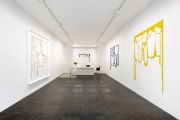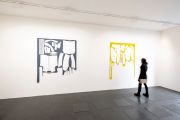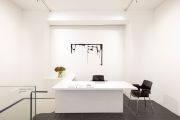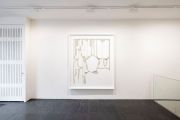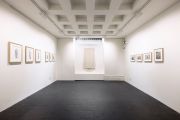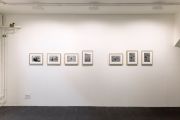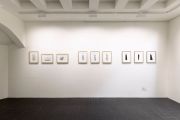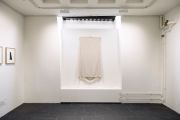Marion Baruch
“Fabric for me is a living, pulsating material, I feel the indescribability of its breath or flow, a continuous flow that is also the flow of an entire society. The textile fabric reflects the history of humanity and at the same time the social dimension of the work.”
– Marion Baruch, 2018
After a series of exhibitions abroad, Galerie Urs Meile is pleased to offer a glimpse into the extensive oeuvre of Romanian artist Marion Baruch at its Zurich location.
Born in 1929 in the Romanian town of Timișoara, Baruch went through numerous changes of residence over the years, from Israel to Italy, England, and France, until she finally settled in Gallarate, an Italian town in close proximity to the fashion capital of Milan. Social and cultural influences of her various habitats, as well as her deep involvement with different languages – Marion Baruch speaks Romanian, Hungarian, German, French, English Italian and Iwrit – the language of Israel – are reflected in her work.
Baruch’s extensive body of work has undergone dramatic stylistic shifts; from expressive painting to printmaking; from large metal sculptures to her groundbreaking performative works Contenitore-Ambiente and Abito-Contenitore (translated as “ambient container” and “clothing container”) (ca. 1971). Marion Baruch realizes the idea of a sculpture activated by the human body in collaboration with Italian designer and architect AG Fronzoni. Depending on how Abito-Contenitore is worn, it resembles a religious habit, a geometric sculpture, or an outright living abstraction. Marion Baruch attracted the attention of the media when, dressed in Abito-Contenitore, she walked along Via Monte Napoleone, Milan’s most important fashion street. A few days later, a photo of this event graces the cover of the Italian news magazine “Panorama”.
Marion Baruch thus hits on the theme of the time: the gap between fashion and tradition, the image of women and the status of women in society. She raises socio-critical questions and makes her contribution to a discussion that is still relevant today. Almost simultaneously she creates the work Contenitore-Ambiente: a sphere made of Plexiglas, large enough to house a human body. In this work, too, the relationship of the body to its environment is the theme. Complementary to this, already here, as in many of Baruch’s works, her invitation to the viewer to participate in the work and thus breathe life into it becomes clear. The spirit of the times is immanent in all these works, the social upheaval, the playful approach, the liberation of the body from constraints and, especially in Abito-Contenitore, also the question of what it means to cover, to wrap, to drape the female body. In collaboration with the Italian photographer Gianni Berengo Gardin, Marion Baruch captures both performative works in photo series.
The current exhibition presents for the first time the reissued editions of the two photo series Abito-Contenitore and Contenitore-Ambiete (1971 - 2023, Re-Edition; Edition of 5, silver gelatin print, each 19 x 28.3 cm (print); each 24 x 30 cm (paper); each 34.5 x 43. 5 cm (frame)).
Marion Baruch comes into contact with fabrics as a working material at an early stage in her career, but it is not until 2012 when she begins a new series of works that she explores in depth the artistic potential of textiles. By chance she comes across a lot of fabric scraps from the textile production of the Prêt-à Porter industry around Milan. Marion Baruch thus gives this disposable product a second life and elevates it to a work of art by reusing it. The way she selects, combines and exhibits these materials vividly demonstrates Marion Baruch’s reflections on language, body, space and emptiness. The result are artworks with a distinctive formal language that she calls “ready-resti/Lampi di memoria” (in German “flashes of memory”). She adds nothing to the fabrics, decides only on the way they are presented in space, and gives them a specific title that describes the story behind each work.
The four fabric works presented, La musique autour d’un bassin, Osservatorio, Lattemiele, and Complementari are also such revived remnants. In La musique autour d’un bassin (2018, cotton, 183 x 146 cm; 215 x 180 cm (framed)), the title refers to the blank spaces created in the production process, which resemble musical symbols - notes and rests - in a musical score. The large blank space in the center of the work corresponds to a part of the pattern intended for the hip and pelvic area, playing on the double meaning of “bassin” in French, which can mean both a pond and a body part. Osservatorio (2018, blue “air force” fabric, 185 x 160 cm) draws its inspiration from a blank space at the top of the fabric, which resembles a large eye and seems to look down on the viewer. Lattemiele (2023, fabric, 187 x 148 cm) literally translates as “milk” and “honey” and alludes to the drink of the same name, whose sweetness and warmth evoke comfort. The interplay between white wall and yellow fabric, with its soft, falling segments, evokes the mixing of honey with milk. The hexagonal pattern draws parallels to beehive structures. In Complementari (2022, cotton, 89 x 128 cm), the title is a reference to a simple but important connection between the two primary colors, red and blue, of which the work is composed.
And connections are what Baruch is all about; at the core of her work is the human and its relationships to and within society. A multilingualism is found, whose intercultural character is given a face. Her work can thus be read on many levels and touches not only ethical, social and economic dimensions, but goes into their individual mechanisms, discusses, debates and sets them in dialogue with each other. It encourages further development, further thinking, “becoming”. In her language, Marion Baruch extends an invitation to participate in a game with humor, to take a different perspective for a change.
October 20 – November 11, 2023
Extended to November 25, 2023
Galerie Urs Meile Zurich
Downloads
Opening
Friday, October 20, 2023, 6.00 - 8.00 pm
Opening Hours
Wednesday to Friday, 11.00 am – 6.00 pm
Saturday, 11.00 am - 5 pm
Exhibition Views

